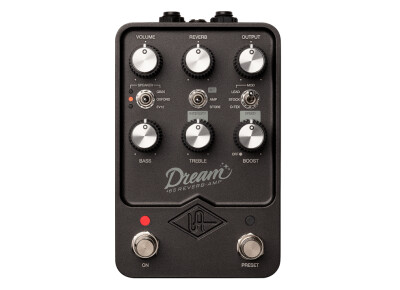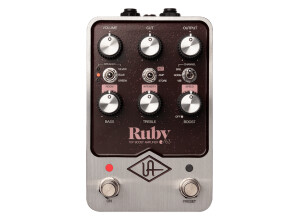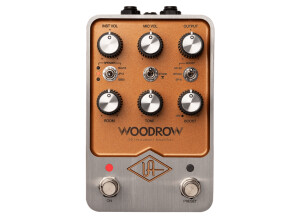Where to buy Dream '65 Reverb Amplifier?
Less
Best new price
See more offers
Tech. sheet
- Manufacturer: Universal Audio
- Model: Dream '65 Reverb Amplifier
- Series: UAFX
- Category: Guitar Amp Simulation Pedals
- Package weight:806 g
- Other names:dream 65 reverbamplifier, dream65reverbamplifier, dream65 reverbamplifier, dream65 reverb amplifier, dream 65reverb amplifier
We have no technical specifications for this product
but your help will be much welcomed
Distributed by Universal Audio USA
»
Videos
User reviews
5.0/5(1 reviews)
5
100 %
4
3
2
1
Pure Fender Sounds in a Pedal - Authentic!
Published on 05/30/23 at 11:52I supposed I could joke about how this is a guitarist’s ‘Wet Dream,’ but the name Dream ’65 will suffice. Emulated from select 1965 Fender Super Reverb amps, as well as select speaker emulations, UA got as close as possible to a real amp that I have heard. And that goes for their Woodrow (Tweed) and Ruby (AC30) counterparts. I will address a few details, although they are demonstrated in the accompanying video, but first the basics. Think of Dream ’65 as a Fender Super Reverb amp, with stereo ins and outs. You have access to six select Speakers (imagine six cabinets), each providing a different tone/sound, and three Amp Modifications (Boosts), and with built-in Vibrato & Spring Reverb....…
Read more
I supposed I could joke about how this is a guitarist’s ‘Wet Dream,’ but the name Dream ’65 will suffice. Emulated from select 1965 Fender Super Reverb amps, as well as select speaker emulations, UA got as close as possible to a real amp that I have heard. And that goes for their Woodrow (Tweed) and Ruby (AC30) counterparts. I will address a few details, although they are demonstrated in the accompanying video, but first the basics. Think of Dream ’65 as a Fender Super Reverb amp, with stereo ins and outs. You have access to six select Speakers (imagine six cabinets), each providing a different tone/sound, and three Amp Modifications (Boosts), and with built-in Vibrato & Spring Reverb. On that note, both the Vibrato and Reverb sound spectacular. Some may argue the reverb is not quite as good as a real tank, but this is very close. The Vibrato has a very natural and organic flow to it.
This amp has the basic functions, including Volume, Output, Reverb, Bass & Treble (the Treble and Boost double as Vibrato rate and intensity respectively) and an on/off switch. It also has a Pre-set switch, so that you can save a favorite sound and switch back-and-forth with a different knob setting, viz., a two-channel amp. Of course, add a distortion, fuzz or OD to the front end and you have three unique sounds… clean… crunch… lead. You certainly can get away with just the Dream ‘65 and its internal mods when playing lead, but for those who want a more modern and higher-gain sound, then a front-end pedal may be required.
Here is the tricky or ‘adjustment’ part of the amp. One of the mods or Boosts is based on the Stevie Ray Vaughan sound, and it is great! However, you cannot apply Vibrato IF you use that mod. I thought it would be ideal if this could be achieved, since SRV is known for combining a Super Verb with Vibroverb. Regardless, there is a toggle switch that allows you to switch between Amp and Alt (Vibrato function), and that switch also serves to save the Preset. If you select the SRV mod, then Vibrato automatically shuts off. If you select the other two mods, then you will hear the Vibrato IF you set it (you can switch back to the Bass & Treble controls, but Vibrato remains UNTIL you flip the toggle to ALT and reduce both Vibrato rate & intensity to zero). And if using those other two mods, and you do not hear any vibrato, then you must flip to Alt and set the Vibrato (and while setting it, Bass/Treble do not work). The video will clarify this and it is not as complicated as it may sound. While in the ALT mode, the Bass knob also doubles as a Room function, which adds studio atmosphere or room ambience to the sound, making it more realistic to the ears. This is a great tool for clean or slightly dirty tones.
The other two modifications or Boosts are Lead (‘80s OD) and Stock (clean preamp boost). The latter says it all, and you do not hear much compression or saturation with this one. The Lead mod sings best with its level past noon, and provides a less beefy OD than the SRV mod – however, the Lead mod is smoother and ideal for a lead that sings rather than screams.
As mentioned, there are six speaker types, all of which are very useful (completely different results and tones). These match up so well with different guitars in my studio that I do not see the need for different speakers. But just like the Woodrow and Ruby, Dream ’65 allows you to bypass the internal speakers and go direct to a preferred IR.
Overall, if you are into amp modeling or emulation, all three UA pedals have surpassed the competition – although I am basing this on my ears, and this also is the reason why I now have all three in my studio as my primary amps. I do have other amps, including tube and solid state, and I enjoy them, but the sound, size and simplicity of these pedals have caused me to leave the digital modeling world, insofar as amps are concerned. What I find modeling lacks is in producing authentic feel or sound quality (although very decent over the past 3-4 years), but also the simplicity of an amp, with dozens of things that could be tweaked, to the point that you get ear fatigue and it is difficult to dial into a great tone as easily. Now, before lambasts me about not liking digital modeling, I do realize that a quality IR makes all the difference, but I have not delved too deep into that realm. Any time I do use modeling for some high-gain tones, it is with a third-party IR, and yes, they make a significant difference.
Dream ’65 does require a 400mA power supply (most bricks can handle this), and it does not have MIDI or an FX Loop. That may turn off some people, but this is emulated from 1965 amps, and that is what you are getting. On the plus side, it is an excellent pedal platform, since it is so clean (or can be set slightly breaking up to play well with high-gain gear), and it can become a secondary amp via a 4-cable method. If you have a regular AC30 or Marshall, for example, you now can have Fender Super Reverb sounds.
What would I change about the Dream ’65? First, I would like to have the Vibrato function work with the SRV modification, which I think is most obvious to me. Second, I like the two-tone look of the Woodrow and Ruby (brushed aluminum framing with a color in the center). I think the Dream would look as spiffy if it were not all black and had that aluminum framing. Regardless, I am not that finicky about a pedal’s looks, as compared to a guitar, and the Dream ’65 is addictive to play through.
This amp has the basic functions, including Volume, Output, Reverb, Bass & Treble (the Treble and Boost double as Vibrato rate and intensity respectively) and an on/off switch. It also has a Pre-set switch, so that you can save a favorite sound and switch back-and-forth with a different knob setting, viz., a two-channel amp. Of course, add a distortion, fuzz or OD to the front end and you have three unique sounds… clean… crunch… lead. You certainly can get away with just the Dream ‘65 and its internal mods when playing lead, but for those who want a more modern and higher-gain sound, then a front-end pedal may be required.
Here is the tricky or ‘adjustment’ part of the amp. One of the mods or Boosts is based on the Stevie Ray Vaughan sound, and it is great! However, you cannot apply Vibrato IF you use that mod. I thought it would be ideal if this could be achieved, since SRV is known for combining a Super Verb with Vibroverb. Regardless, there is a toggle switch that allows you to switch between Amp and Alt (Vibrato function), and that switch also serves to save the Preset. If you select the SRV mod, then Vibrato automatically shuts off. If you select the other two mods, then you will hear the Vibrato IF you set it (you can switch back to the Bass & Treble controls, but Vibrato remains UNTIL you flip the toggle to ALT and reduce both Vibrato rate & intensity to zero). And if using those other two mods, and you do not hear any vibrato, then you must flip to Alt and set the Vibrato (and while setting it, Bass/Treble do not work). The video will clarify this and it is not as complicated as it may sound. While in the ALT mode, the Bass knob also doubles as a Room function, which adds studio atmosphere or room ambience to the sound, making it more realistic to the ears. This is a great tool for clean or slightly dirty tones.
The other two modifications or Boosts are Lead (‘80s OD) and Stock (clean preamp boost). The latter says it all, and you do not hear much compression or saturation with this one. The Lead mod sings best with its level past noon, and provides a less beefy OD than the SRV mod – however, the Lead mod is smoother and ideal for a lead that sings rather than screams.
As mentioned, there are six speaker types, all of which are very useful (completely different results and tones). These match up so well with different guitars in my studio that I do not see the need for different speakers. But just like the Woodrow and Ruby, Dream ’65 allows you to bypass the internal speakers and go direct to a preferred IR.
Overall, if you are into amp modeling or emulation, all three UA pedals have surpassed the competition – although I am basing this on my ears, and this also is the reason why I now have all three in my studio as my primary amps. I do have other amps, including tube and solid state, and I enjoy them, but the sound, size and simplicity of these pedals have caused me to leave the digital modeling world, insofar as amps are concerned. What I find modeling lacks is in producing authentic feel or sound quality (although very decent over the past 3-4 years), but also the simplicity of an amp, with dozens of things that could be tweaked, to the point that you get ear fatigue and it is difficult to dial into a great tone as easily. Now, before lambasts me about not liking digital modeling, I do realize that a quality IR makes all the difference, but I have not delved too deep into that realm. Any time I do use modeling for some high-gain tones, it is with a third-party IR, and yes, they make a significant difference.
Dream ’65 does require a 400mA power supply (most bricks can handle this), and it does not have MIDI or an FX Loop. That may turn off some people, but this is emulated from 1965 amps, and that is what you are getting. On the plus side, it is an excellent pedal platform, since it is so clean (or can be set slightly breaking up to play well with high-gain gear), and it can become a secondary amp via a 4-cable method. If you have a regular AC30 or Marshall, for example, you now can have Fender Super Reverb sounds.
What would I change about the Dream ’65? First, I would like to have the Vibrato function work with the SRV modification, which I think is most obvious to me. Second, I like the two-tone look of the Woodrow and Ruby (brushed aluminum framing with a color in the center). I think the Dream would look as spiffy if it were not all black and had that aluminum framing. Regardless, I am not that finicky about a pedal’s looks, as compared to a guitar, and the Dream ’65 is addictive to play through.
See less
00
»
Other Universal Audio guitar Amp Simulation Pedals
Other categories in Guitar Amp Simulators
Where to buy Dream '65 Reverb Amplifier?
Less
Best new price
See more offers














